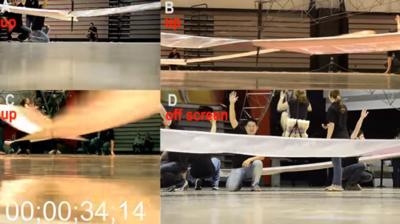Wed, May 11, 2016
The Gamera Project Achieved The Milestone In 2011
On May 12, 2011, biology student and female pilot Judith Wexler flew the human-powered helicopter “Gamera I” for 4.2 seconds in College Park, MD (USA), thus setting the first ever FAI world record in this type of aircraft.

The “Gamera Project” was introduced to try and achieve the dream of human-powered hovering flight. No less than fifty graduate and undergraduate students from the Alfred Gessow Rotorcraft Center of the University of Maryland’s Department of Aerospace Engineering participated in the design and construction of Gamera I. It was made of several lightweight composites and foam, the total weight of this quadrotor helicopter was just about 210 pounds including the pilot. It was built of four trusses, each with a rotor. Both hand and foot pedalling drive the rotors for improved performance. Four cameras were positioned to film the attempt, as the aircraft was so large.
For such records three factors are essential: design, weight, and power. In order to increase the altitude and time in the air, reducing the weight of the aircraft, increasing the efficiency of the rotor design and finding a pilot of just the right size and strength are critical.
Since May 2011, not many records have been set in this very special category. Two months after the first record, Judith managed to supersede her own record with “Gamera II”, a refinement of the “Gamera I”. The current record which was achieved only two years later, is held by Justin Mauch who was airborne for 1 minute and 37.5 seconds. The enormous increase of flight duration between the first and the most recent record shows just how significant and fast the development of human-powered flight has become.
The rules and regulations of Human Powered aircraft are defined in the FAI Sporting Code as an aerodyne that takes off and remains airborne only by direct human muscular energy. It must not use any system of static support such as gas or hot air nor may it carry any kind of apparatus that could receive energy during flight although such equipment may be used to store muscular energy after take-off.
(Source: FAI news release. Image from FAI video)
More News
Airplane Bounced About 3 Ft Then Touched Back Down And Then, With No Brakes Applied, The Airplane Began Veering To The Left Analysis: The pilot entered the airport traffic pattern >[...]
Aero Linx: British Microlight Aircraft Association (BMAA) The primary focus within all aviation activity is SAFETY. In all aspects of our sport SAFETY must come first, whether it b>[...]
From SnF25 (YouTube Edition): William Wynne Builds Practical Aircraft Engines on the Corvair Platform Seeking an affordable alternative to the traditional aircraft engine options, >[...]
How To Get A Story On Aero-TV News/Feature Programming How do I submit a story idea or lead to Aero-TV? If you would like to submit a story idea or lead, please contact Jim Campbel>[...]
From 2023 (YouTube Edition): Bridge of CiES CiES Inc. is a Bend, Oregon-based designer and manufacturer of modular embedded aircraft systems and sensors. The company’s fuel-l>[...]
 NTSB Final Report: Aviat A1
NTSB Final Report: Aviat A1 ANN's Daily Aero-Linx (07.08.25)
ANN's Daily Aero-Linx (07.08.25) Classic Aero-TV: Fly Corvairs Reliable Engine Alternative
Classic Aero-TV: Fly Corvairs Reliable Engine Alternative ANN FAQ: Contributing To Aero-TV
ANN FAQ: Contributing To Aero-TV Classic Aero-TV: CiES Fuel-Quantity and e-Throttle Systems Praised
Classic Aero-TV: CiES Fuel-Quantity and e-Throttle Systems Praised



